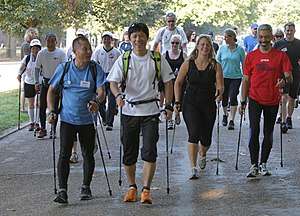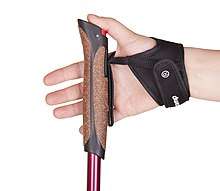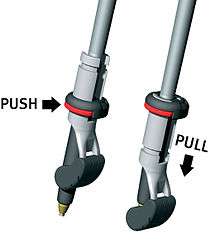Nordic walking
Nordic walking is a total-body version of walking that can be enjoyed both by non-athletes as a health-promoting physical activity, and by athletes as a sport. The activity is performed with specially designed walking poles similar to ski poles.

History
Nordic walking (originally Finnish sauvakävely) is fitness walking with specially designed poles. While trekkers, backpackers and skiers had been using the basic concept for decades, Nordic walking was first formally defined with the publication of "Hiihdon lajiosa" (translation: "A part of cross-country skiing training methodic") by Mauri Repo in 1979.[1] Nordic walking's concept was developed on the basis of off-season ski-training activity while using one-piece ski poles.[2]

For decades hikers and backpackers used their one-piece ski poles long before trekking and Nordic walking poles came onto the scene. Ski racers deprived of snow have always used and still do use their one-piece ski poles for ski walking and hill bounding. The first poles specially designed and marketed to fitness walkers were produced by Exerstrider of the US in 1988. Nordic Walker poles were produced and marketed by Exel in 1997. Exel coined and popularized the term 'Nordic Walking' in 1999.
Benefits
Compared to regular walking, Nordic walking (also called pole walking) involves applying force to the poles with each stride. Nordic walkers use more of their entire body (with greater intensity) and receive fitness building stimulation not present in normal walking for the chest, latissimus dorsi muscle, triceps, biceps, shoulder, abdominals, spinal and other core muscles that may result in significant increases in heart rate at a given pace.[3] Nordic walking has been estimated as producing up to a 46% increase in energy consumption, compared to walking without poles.[4][5]
According to the findings of the research, conducted by the group scientists from various universities*, both Nordic walking and conventional walking are beneficial for older adults. However, Nordic walking provides additional benefits in muscular strength compared to conventional walking, making it suitable for improving aerobic capacity and muscular strength as well as other components of functional fitness in a short period of time. The key points stated by the study authors are:
- Nordic walking, conventional walking, and resistance training are beneficial for older adults.
- Nordic walking and conventional walking both improve cardio-respiratory fitness while resistance training does not.
- Nordic walking provides additional benefits in upper-body muscular strength compared to conventional walking.
- Nordic walking is an effective and efficient mode of exercise to improve overall fitness in older adults.
- National Institute of Fitness and Sports in Kanoya, Kanoya, Japan; Department of Rehabilitation, Yonaha General Hospital, Kuwana, Mie, Japan; Wichita State University, Wichita, KS, USA; Active Aging Association, Nagoya, Japan; Nagoya City University, Nagoya, Japan. 2013
Equipment


Nordic walking poles are significantly shorter than those recommended for cross-country skiing. Nordic walking poles come in one-piece, non-adjustable shaft versions, available in varying lengths, and telescoping two or three piece twist-locking versions of adjustable length. One piece poles are generally stronger and lighter, but must be matched to the user. Telescoping poles are 'one-size fits all', and are more transportable.
Nordic walking poles feature a range of grips and wrist-straps, or rarely, no wrist-strap at all. The straps eliminate the need to tightly grasp the grips. As with many trekking poles, Nordic walking poles come with removable rubber tips for use on hard surfaces and hardened metal tips for trails, the beach, snow and ice. Most poles are made from lightweight aluminium, carbon fiber, or composite materials. Special walking shoes are not required, although there are shoes being marketed as specifically designed for the sport.
Technique
The cadences of the arms, legs and body are, rhythmically speaking, similar to those used in normal, vigorous, walking. The range of arm movement regulates the length of the stride. Restricted arm movements will mean a natural restricted pelvic motion and stride length. The longer the pole thrust, the longer the stride and more powerful the swing of the pelvis and upper torso.
Country members
- Stichting Nordic Walking Nederland – Member Since 2003
- (AENWC) INWA Spain – Member Since 2005
- Associazione Nordic Walking Italia – Member Since 2005
- Nordic Walking Australia – Member Since 2006
- Japan Nordic Fitness Association (JNFA) – Member Since 2007
- Latvian Sports for All Association – Member Since 2008
- Nordic Walking Fitness Association of New Zealand – Member Since 2008
- British Nordic Walking
- INWA Israel Hapoel
- INWA Korea
- INWA France
- Estonian Nordic Walking Union
- Russian Nordic Walking Association (RNWA) – Member Since 2010
- Zhejiang Sports Tourism Industry Promotion Association – Member Since 2010
- Croatian Nordic Walking Association – Member Since 2011
- Nordic Walking Association INDIA – Member Since 2012
- Federation of Iraqi Sports Companies – Member Since 2017
- Nordic Walking Finland – Member Since 2017
- Iranian Nordic Walking Association – Member Since 2017
- TRULY GRAND FIGHTING CHAMPIONSHIP (AFGHANISTAN) – Member Since 2018
See also
References
- "KOULUTUSAINEISTOA MAURI REPO : SEURAVALMENTAJAN PERUSTIEDOT HIIHDON LAJIOSA" (PDF). Tul.fi. Archived from the original (PDF) on 1 January 2014. Retrieved 28 December 2017.
- "The History of Nordic Walking". Inwa-nordic-walking.com. 29 May 2014. Retrieved 28 December 2017.
- Medicine & Science in Sports & Exercise VOL. 27, NO. 4 April1995:607–11
- Cooper Institute, Research Quarterly for Exercise and Sports, 2002
- Church, TS; Earnest, CP; Morss, GM (25 March 2013). "Field testing of physiological responses associated with Nordic Walking". Res Q Exerc Sport. 73 (3): 296–300. doi:10.1080/02701367.2002.10609023. PMID 12230336.
External links
